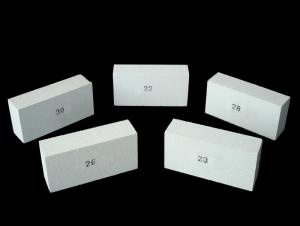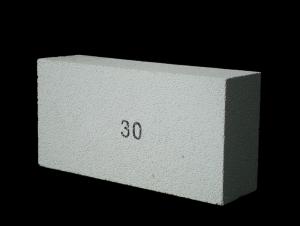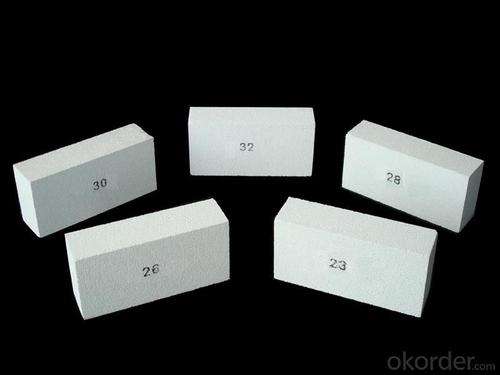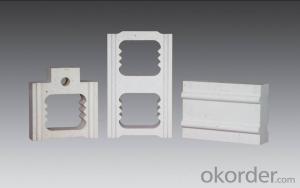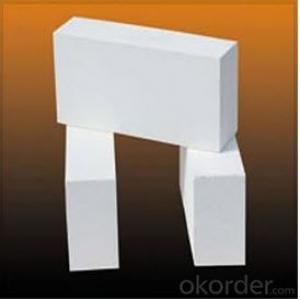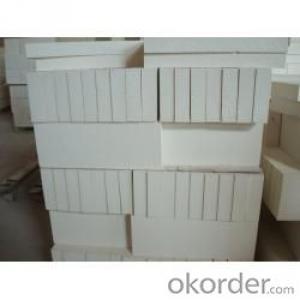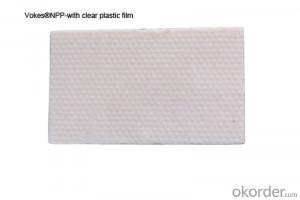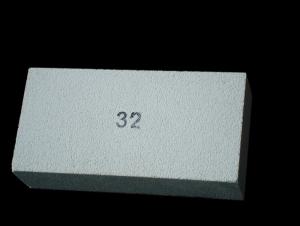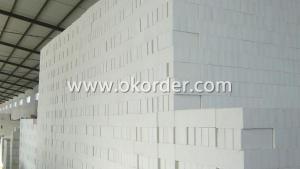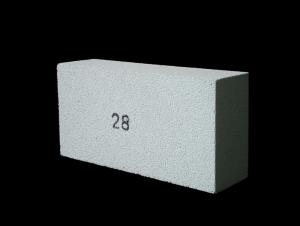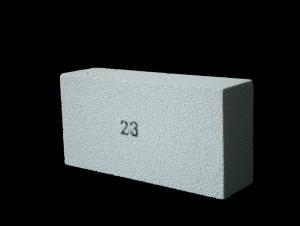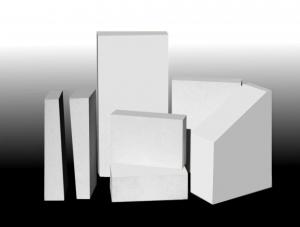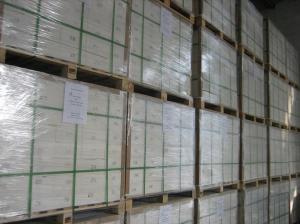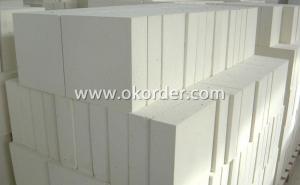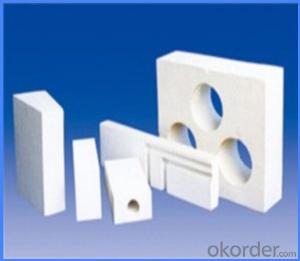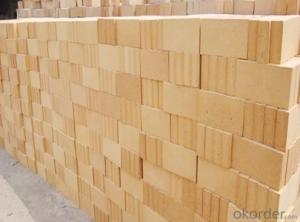Insulating Fire Brick - MS30
- Loading Port:
- China Main Port
- Payment Terms:
- TT or L/C
- Min Order Qty:
- 1000 pcs pc
- Supply Capability:
- 1000 Tons Per Month pc/month
OKorder Service Pledge
OKorder Financial Service
You Might Also Like
General Information of Insulating Fire Bricks MS30
Insulating fire brick MS30 are produced by mixing, extruding, drying, sintering and grinding. Our insulating fire bricks MS30 temperature is 1650℃(3000℉). We could supply a wide range of shapes.
Feature of Insulating Fire Bricks MS30
Light weight and low thermal conductivity
Low heat storage
Low iron and impurities
High thermal shock resistance
Application of Insulating Fire Bricks MS30
The insulating firebricks can be used as a hot face lining directly exposed to the heat or as a backup insulation layer in iron and steel mills, non-ferrous foundries, petrochemical, ceramic, glass.
Data Sheet of Insulating Fire Bricks MS30
|
| MS30 |
Physical Properties: |
|
|
Classifiction Temperature | ℃ | 1600.0 |
Density | Kg/m3 | 1000.0 |
Cold Crushing Strength | Mpa | 2.8 |
Reheating Linear Change(24hrs) |
|
|
1600℃ | % | 0.7 |
Hot Load Strength Deform(90 minutes) |
|
|
1370℃ at 0.069 Mpa(10psi) | % | 0.2 |
Thermal Conductivity |
|
|
400℃ | W/m.k | 0.3 |
600℃ | W/m.k | 0.3 |
800℃ | W/m.k | 0.4 |
1000℃ | W/m.k | 0.4 |
1200℃ | W/m.k | 0.4 |
Specific Heat | KJ/Kg.K | 1.1 |
Chemical Analysis: |
|
|
Al2O3 | % | 70.0 |
SiO2 | % | 28.3 |
Fe2O3 | % | 0.5 |
TiO2 | % | 0.1 |
CaO | % | 0.1 |
MgO | % | 0.1 |
Na2O+K2O | % | 0.7 |
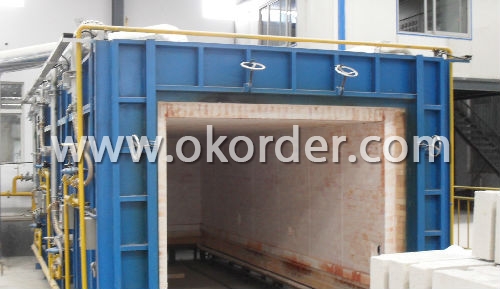
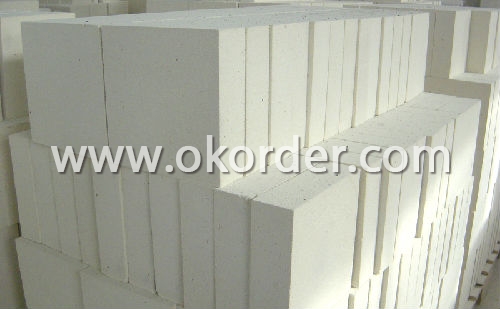
- Q: Can insulating fire bricks be used in power plants?
- Yes, insulating fire bricks can be used in power plants. Insulating fire bricks, also known as refractory bricks, are designed to withstand high temperatures and provide excellent thermal insulation. They are commonly used in various industrial applications, including power plants. Power plants generate a significant amount of heat during the combustion of fossil fuels or the process of nuclear fission. To maintain efficient operations and prevent heat loss, insulating fire bricks are used to line the walls, floors, and ceilings of furnaces, boilers, and other high-temperature areas in power plants. Insulating fire bricks have low thermal conductivity, which means they are effective at reducing heat transfer. This helps to conserve energy and improve the overall efficiency of power plants. Additionally, they have high resistance to thermal shock, meaning they can withstand rapid temperature changes without cracking or breaking. Moreover, insulating fire bricks are lightweight and easy to install, making them a practical choice for power plant applications. They are also resistant to chemical corrosion, which is important in power plants where various gases and chemicals are present. In conclusion, insulating fire bricks are a suitable choice for power plants due to their ability to withstand high temperatures, provide excellent thermal insulation, and resist thermal shock and chemical corrosion. Using these bricks in power plant applications helps to enhance energy efficiency and maintain optimal operating conditions.
- Q: Are insulating fire bricks suitable for outdoor applications?
- Insulating fire bricks are generally unsuitable for outdoor use. They are designed for high-temperature environments like kilns, furnaces, and industrial settings, offering excellent thermal insulation and withstanding extreme heat. Nevertheless, insulating fire bricks are vulnerable to moisture, rain, and harsh weather conditions outdoors. They can easily be damaged and are not resistant to freezing and thawing, leading to cracks and breakage. For outdoor applications, it is advisable to opt for fire bricks specifically designed for such purposes. These bricks are typically made of dense clay or other materials that can endure moisture and weather conditions. They are more robust and offer superior protection against the elements. Before choosing the appropriate fire bricks for your outdoor needs, it is essential to take into account the specific requirements and conditions of your application. Seeking guidance from a knowledgeable professional or supplier in fire bricks can ensure that you select the suitable product for your requirements.
- Q: Are insulating fire bricks resistant to erosion?
- Yes, insulating fire bricks are resistant to erosion.
- Q: Can insulating fire bricks be used in ladles?
- Yes, insulating fire bricks can be used in ladles.
- Q: Are insulating fire bricks suitable for use in high-temperature chimneys?
- Yes, insulating fire bricks are suitable for use in high-temperature chimneys. These bricks are specifically designed to withstand extreme temperatures and provide excellent insulation properties. They have a high melting point and low thermal conductivity, which allows them to effectively retain heat and prevent it from escaping through the chimney walls. This helps in maintaining a high temperature inside the chimney, which is crucial for efficient combustion and proper functioning of the chimney. Additionally, insulating fire bricks are lightweight and durable, making them an ideal choice for constructing chimneys that are exposed to high temperatures.
- Q: Can insulating fire bricks be used in high-temperature kilns and furnaces?
- High-temperature kilns and furnaces can indeed utilize insulating fire bricks. These bricks are specifically designed to endure extreme heat and offer remarkable insulation properties. They consist of lightweight refractory materials, including clay and silica, which possess high melting points and low thermal conductivity. By effectively retaining heat, these bricks decrease energy loss and enhance the efficiency of the kiln or furnace. Moreover, insulating fire bricks exhibit excellent resistance to thermal shock, enabling them to withstand rapid temperature fluctuations without cracking or breaking. Consequently, they are well-suited for high-temperature applications that involve frequent heating and cooling cycles in kilns or furnaces. All in all, insulating fire bricks represent an ideal choice for insulating and safeguarding high-temperature kilns and furnaces.
- Q: Are insulating fire bricks suitable for use in high-temperature chimneys?
- Yes, insulating fire bricks are suitable for use in high-temperature chimneys. These bricks are specifically designed to withstand extreme temperatures and provide excellent insulation properties. They have a high melting point and low thermal conductivity, which allows them to effectively retain heat and prevent it from escaping through the chimney walls. This helps in maintaining a high temperature inside the chimney, which is crucial for efficient combustion and proper functioning of the chimney. Additionally, insulating fire bricks are lightweight and durable, making them an ideal choice for constructing chimneys that are exposed to high temperatures.
- Q: Can insulating fire bricks be used for insulation in refractory lining repair?
- Indeed, insulation in refractory lining repair can be achieved by utilizing insulating fire bricks. Crafted from lightweight materials, these bricks boast exceptional thermal insulation properties, rendering them perfectly suitable for employment in high-temperature settings like furnaces, kilns, and other refractory lining structures. Their low thermal conductivity and impressive resistance to thermal shock enable them to effectively insulate and safeguard the refractory lining against heat, thereby averting heat loss and diminishing energy consumption. Additionally, the installation and replacement of insulating fire bricks are effortless, solidifying their position as a cost-efficient alternative for refractory lining repair.
- Q: Can the whole wall of the high-rise building be made of grey insulation bricks?
- If the frame structure, it may be so. What is the length of the whole wall? If it is longer, it is necessary to make a constructional column; if the hole is larger, the edge of the hole needs to be made into a border or a constructional column; if the entrance is small, the edge of the hole is about 300mm and needs solid bricks to build better. South wall thickness can be about 190mm, plus plastering design value of 200mm. Personal comments for reference!
- Q: Are insulating fire bricks environmentally friendly?
- Insulating fire bricks can be considered environmentally friendly to some extent. They are made from natural materials, such as clay and shale, which are abundant and readily available. Additionally, their insulating properties can help reduce energy consumption in various applications, leading to lower carbon emissions. However, the manufacturing process may involve the use of high temperatures and kilns, which can contribute to air pollution. Furthermore, the disposal of these bricks at the end of their lifespan may pose challenges in terms of waste management. Thus, while insulating fire bricks have certain eco-friendly aspects, their overall environmental impact depends on various factors.
1. Manufacturer Overview
| Location | Jiangsu, China |
| Year Established | 2008 |
| Annual Output Value | Above US$ 35 Million |
| Main Markets | Germany; Italy; Turkey; France; England; Japan; Thailand; Vietnam; Idonesia; USA |
| Company Certifications | ISO 9001:2008 |
2. Manufacturer Certificates
| a) Certification Name | |
| Range | |
| Reference | |
| Validity Period |
3. Manufacturer Capability
| a) Trade Capacity | |
| Nearest Port | Shanghai; Qingdao |
| Export Percentage | 10% |
| No.of Employees in Trade Department | 3 People |
| Language Spoken: | English; Chinese; |
| b) Factory Information | |
| Factory Size: | Twenty five thousand tons per year |
| No. of Production Lines | Above 5 |
| Contract Manufacturing | OEM Service Offered; Design Service Offered |
| Product Price Range | High; Average |
Send your message to us
Insulating Fire Brick - MS30
- Loading Port:
- China Main Port
- Payment Terms:
- TT or L/C
- Min Order Qty:
- 1000 pcs pc
- Supply Capability:
- 1000 Tons Per Month pc/month
OKorder Service Pledge
OKorder Financial Service
Similar products
Hot products
Hot Searches
Related keywords
